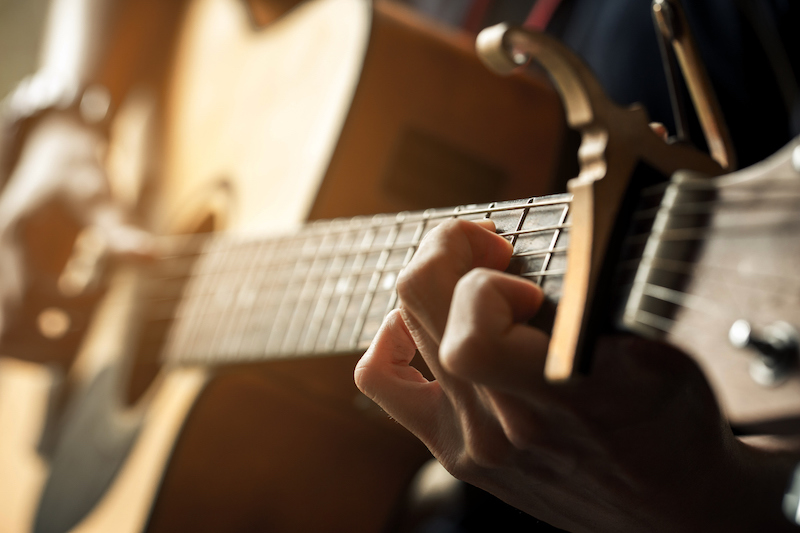Beginner’s Guide to Reading Guitar TABs (+ 20 Songs to Try)

If you are new to guitar, then you may be overwhelmed with all there is to learn about your new instrument such as reading guitar TABs. However, between learning music theory and chords and just getting comfortable playing the guitar, beginners find themselves anxious to play a familiar tune.
Thankfully, every now and then, a method will come along that helps to make music flow more seamlessly. For guitars, it is all in the TABs. Here is your beginner’s guide to reading guitar TABs and, just because we know that you will want to give it a try, we’ve included 20 songs so you can get started right away.
What Exactly Are Guitar TABs?
The TAB is short for tablature. This is just a fancy way of referring to a method for beginning guitarists to learn to play easily and quickly. Guitar TABs are used along with a regular staff with music notation. It tells you what you need to play and how to play it.
Note that the tablature is usually printed underneath the staff to reflect both the music and the TABs reading together. The difference? The guitar tablature tells you what note to play and tells you where to play the notes on your guitar. It gives you a visual to learning new songs.
Learning Your String’s Tunings
Since this is for beginners, there is a good chance you have a guitar with six strings. If not, you will require a few alterations. Again, though, the method is relatively the same. Each string on your guitar has a number and a tuning.
They range from the thinnest string (the first string) to the thickest string (the sixth string). As you learn to read the tablature, you will understand the view it gives as you see it when looking down at your guitar. The TAB looks like this:
When holding your guitar, you look down and see that the top string is your sixth string, and it’s an “e” and the string below it is a “B” and so forth.
Learning the Numbers
As you review the guitar TAB on a piece of sheet music, you will see that within the tab, there will be numbers ranging from 0 to 24. Each number corresponds precisely to the notes in the regular staff above the tab. Therefore, each number represents which fret you are going to play that string.
The frets (aka fretboards) on your guitar are the spaces between the metal strips along the neck of the guitar. The first fret is the one that is closest to the nut, or headstock. As you learn to play TABs, you will discover that 0 means you are not using any frets, 1 tells you to play the first fret, 5 tells you to play the fifth fret, 8 is telling you to play the eighth fret, and so on.
Chords
Playing chords is a part of playing guitar – you are going to play a lot of them. When you come across a tab with a list of numbers stacked on top of one another, that is a chord. And all those numbers are to be played together at the same time. The result? A beautiful chord to accompany whatever tune is being played or vocalized. This is a general idea of what it looks like:
Putting It Together
Are you beginning to get an idea of how TABs work? Each line in the tablature stands for a note as outlined above. And each fret has a number. So, when there is a number on a particular line, you are playing that note using the designated fret. If we use the basic drawing from above, it will look like this:
And this would appear directly underneath the regular staff with the music notes.
Miscellaneous TAB Symbols: A Very Brief Overview
You will want to dig a bit deeper on these, but to get you started, here are a few symbols you may see in your tablature and a brief description of what they mean:
- P.M.: This is Palm Muting and involves muting the sound by keeping your palm on the strings as you pick.
- Bends: These will appear as arrows and will have you bend the note.
- Slides: Appears as a line between two numbers, asking you to slide from one to the next.
- Vibrato: This is a squiggly line above the note showing vibrato should be used.
The TABs method is a great option to learn how to play the guitar quickly. And although many people will go their entire lives without ever knowing music theory and standard notation, the TABs method is not necessarily a replacement for it. Take advantage of what you can learn quickly – and then indulge yourself in learning as much as you can about music – including these symbols. You will be glad you did!
Give the TABs Method a Whirl
Most musicians agree that there are some songs known to be easy for beginners – especially when learning the TABS method. To help get you started, here are 20 songs to choose from that will not disappoint!
- Happy Birthday
- Come as You Are by Nirvana
- Seven Nation Army by The White Stripes
- Jingle Bells
- Wonderful Tonight by Eric Clapton
- Chasing Cars by Snow Patrol
- Day Tripper by The Beatles
- Amazing Grace
- The theme song from James Bond
- The theme song from The Godfather
- Eye of the Tiger by Survivor
- Killing in the Name by Rage Against the Machine
- Beat It by Michael Jackson
- Silent Night
- Hurt by Johnny Cash
- The theme song for The Simpsons
- I Walk the Line by Johnny Cash
- Redemption Song by Bob Marley and The Wailers
- Iron Man by Black Sabbath
- Wish You Were Here by Pink Floyd
